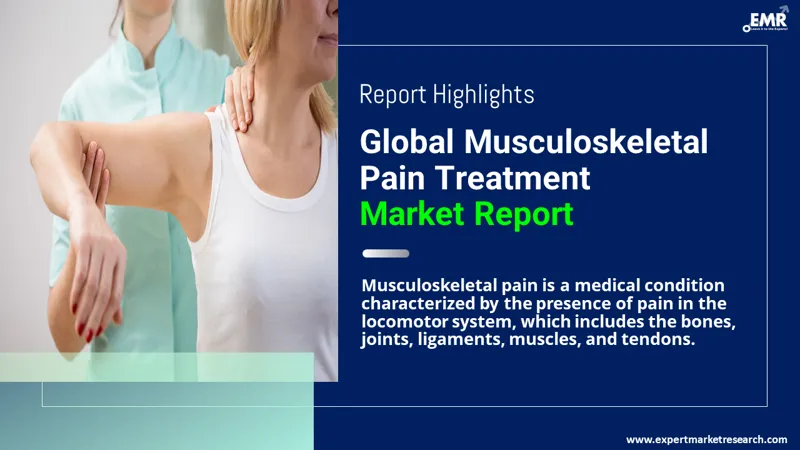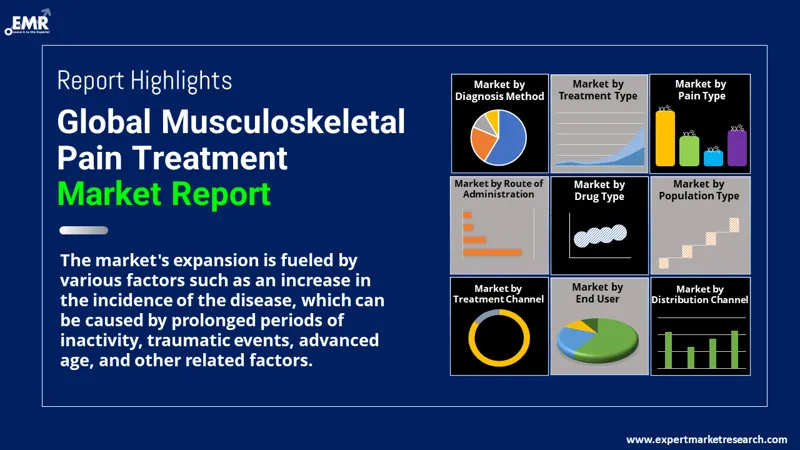
Consumer Insights
Uncover trends and behaviors shaping consumer choices today
Procurement Insights
Optimize your sourcing strategy with key market data
Industry Stats
Stay ahead with the latest trends and market analysis.
The growth of the global musculoskeletal pain treatment market size was driven by the rising prevalence of the condition. The number of cases was close to 29.47 Billion in 2025 and the prevalence is likely to continue growing at a CAGR of 30.50% during the forecast period of 2026-2035 to attain a volume of 422.17 Billion by 2035.
Base Year
Historical Period
Forecast Period
Compound Annual Growth Rate
30.5%
Value in Billion
2026-2035
*this image is indicative*
Musculoskeletal pain is a condition where the patient experiences pain in the locomotor system, comprising of bones, joints, ligaments, muscles, and tendons. This pain might not be continuous and may come in intervals, but it is severe and makes it difficult for the people with this condition to perform physical activities smoothly. For some patients, the pain might be chronic. It can either effect one specific part or the entire body. Musculoskeletal pain is mostly caused due to traumatic incidents like sudden falls or jerking movements, accidents, fractures, sprains, dislocations, and direct blows to the muscle, ligament, or the bone. While these traumatic incidents account for most of the cases, the condition can also be caused due to daily activities or medical conditions like arthritis sometimes. Poor body mechanics and bad posture pose a severe threat to the muscular movement of the body. Other key factors responsible for causing this condition include repetitive movements, strain due to incorrect posture, overuse of a particular muscle, and prolonged immobilization of a body part.

Read more about this report - REQUEST FREE SAMPLE COPY IN PDF
The most common symptoms of this condition include pain in the bone, muscle, ligament, fatigue, and/or disturbed sleep due to pain. This pain can be tolerable or excruciating, depending upon the damage and the location of the injury. If the pain if mild and reduces within some weeks, then it is termed as acute pain, and if it is severe and lasts for months, then it is called chronic pain.
Musculoskeletal pain can also be caused due to some disorders in other vital parts like heart, spleen, lungs, gallbladder, and pancreas, among others. The pain can origin from these points and can radiate to the other parts of the body, like arms or legs. Such musculoskeletal pain is known as referred pain.

Read more about this report - REQUEST FREE SAMPLE COPY IN PDF
The EMR’s report titled “Musculoskeletal Pain Treatment Market Report and Forecast 2026-2035” offers a detailed analysis of the market based on the following segments:
Market Breakup by Diagnosis Method
Market Breakup by Treatment Type
Musculoskeletal Pain Treatment Market Breakup by Pain Type
Market Breakup by Route of Administration
Market Breakup by Drug Type
Market Breakup by Population Type
Market Breakup by Treatment Channel
Market Breakup by End User
Market Breakup by Distribution Channel
Market Breakup by Region
The growth of the market is being driven by the rising cases of accidents as well as rising demand for surgeries, leading to musculoskeletal pain. Rapid technological advancements in the healthcare industry, supported by government initiatives, is further propelling the growth of the market. Based on regions, North America is anticipated to account for the largest market share owing to the developed healthcare sector, supported by the presence of industry leaders in the region. The increasing prevalence of arthritis in the region is also a key factor contributing to the growth of the musculoskeletal pain treatment market in the region. The rising technological advancements as well as clinical trials is likely to aid the growth of the market in the coming years.
The recent study on the Global Burden of Disease (GBD) 2019 states that nearly 1.71 billion were diagnosed with musculoskeletal pain. This condition significantly contributes to the number of disabled people across the globe, with lower back pain being the leading type in nearly 160 countries. Geriatric population is more vulnerable to this condition than young people as the bones become weaker as they age.
People earning higher incomes are a higher risk of suffering from the disease due to their inactive lifestyles. However, the number of people suffering from musculoskeletal pain is likely to rise rapidly in the coming years, especially in the low- and middle-income regions. Women are twice as likely as men to suffer from musculoskeletal diseases.
There are various treatments available for musculoskeletal pain in the treatment market. These treatments include medications and/ or surgeries like occupational therapy, acupuncture, chiropractic adjustment, pain relievers, physical therapy, splints, physical therapy, therapeutic massage, and steroid injections, among others.
The most common medications used for the treatment include Acetaminophen (Tylenol®), nonsteroidal anti-inflammatory drugs (NSAIDs) like aspirin, ibuprofen (Advil, Motrin), or naproxen (Aleve), and prescription medications, such as opioids. Prescription drugs that are used to aid sleep include zolpidem (Ambien), ramelteon (Rozerem), and eszopiclone (Lunesta).
The major companies working on the drugs and treatment of musculoskeletal pain and investing in the clinical trials include the following:




*While we strive to always give you current and accurate information, the numbers depicted on the website are indicative and may differ from the actual numbers in the main report. At Expert Market Research, we aim to bring you the latest insights and trends in the market. Using our analyses and forecasts, stakeholders can understand the market dynamics, navigate challenges, and capitalize on opportunities to make data-driven strategic decisions.*
Get in touch with us for a customized solution tailored to your unique requirements and save upto 35%!
The growth of the market was driven by the rising prevalence of musculoskeletal pain, the number of musculoskeletal pain cases reached 29.47 Billion in 2025.
The growth of the market is likely to be driven by the rising prevalence of the disease, which is anticipated to grow at a CAGR of 30.50% during the forecast period of 2026-2035.
The growth of the market is driven by factors like rising prevalence of the disease, triggered by long hours of inactivity, traumatic incidents, and old age, among others.
The rising availability of affordable treatments is a key trend in the market.
The diagnosis methods include blood tests, X-rays, MRI scans, and joint fluid tests, among others.
The treatment methods used for the treatment include medications and surgery.
The pain type can be categorized into bone pain, joint pain, muscle pain, tendon and ligament pain, among others.
The different routes of administration include oral, parentals, and topicals, among others.
The drug types used in the treatment include over the counter and prescription.
The population types include adults and geriatrics, including both male and female.
The treatment channels can be categorised into public and private channels.
The end-user segments include hospitals, specialty clinics, and homecare settings, among others.
The treatment channels can be categorised into hospital pharmacy, retail pharmacy, and online pharmacy, among others.
The major regions in the market are North America, Latin America, the Middle East and Africa, Europe, and the Asia Pacific.
The major players in the market are A Pfizer Inc., Abbvie Inc., Novartis AG, Amgen Inc., Boehringer Ingelheim International GmbH., Merck & Co Inc., Sun Pharmaceutical Industries Ltd., Teva Pharmaceuticals Industries Ltd., AstraZeneca, Ampio Pharmaceuticals Inc., Eli Lilly and Company, Novartis International AG, and Sanofi S.A., among others.
Explore our key highlights of the report and gain a concise overview of key findings, trends, and actionable insights that will empower your strategic decisions.
| REPORT FEATURES | DETAILS |
| Base Year | 2025 |
| Historical Period | 2019-2025 |
| Forecast Period | 2026-2035 |
| Scope of the Report |
Historical and Forecast Trends, Industry Drivers and Constraints, Historical and Forecast Market Analysis by Segment:
|
| Breakup by Diagnosis Method |
|
| Breakup by Treatment Type |
|
| Breakup by Pain Type |
|
| Breakup by Route of Administration |
|
| Breakup by Drug Type |
|
| Breakup by Population Type |
|
| Breakup by Treatment Channel |
|
| Breakup by End User |
|
| Breakup by Distribution Channel |
|
| Breakup by Region |
|
| Market Dynamics |
|
| Competitive Landscape |
|
| Companies Covered |
|
Single User License
One User
USD 5,499
USD 4,949
tax inclusive*
Datasheet
One User
USD 3,299
USD 2,969
tax inclusive*
Five User License
Five User
USD 6,999
USD 5,949
tax inclusive*
Corporate License
Unlimited Users
USD 8,199
USD 6,969
tax inclusive*
*Please note that the prices mentioned below are starting prices for each bundle type. Kindly contact our team for further details.*
Flash Bundle
Small Business Bundle
Growth Bundle
Enterprise Bundle
*Please note that the prices mentioned below are starting prices for each bundle type. Kindly contact our team for further details.*
Flash Bundle
Number of Reports: 3
20%
tax inclusive*
Small Business Bundle
Number of Reports: 5
25%
tax inclusive*
Growth Bundle
Number of Reports: 8
30%
tax inclusive*
Enterprise Bundle
Number of Reports: 10
35%
tax inclusive*
How To Order

Select License Type
Choose the right license for your needs and access rights.

Click on ‘Buy Now’
Add the report to your cart with one click and proceed to register.

Select Mode of Payment
Choose a payment option for a secure checkout. You will be redirected accordingly.
Gain insights to stay ahead and seize opportunities.

Get insights & trends for a competitive edge.

Track prices with detailed trend reports.

Analyse trade data for supply chain insights.

Leverage cost reports for smart savings

Enhance supply chain with partnerships.

Connect For More Information
Our expert team of analysts will offer full support and resolve any queries regarding the report, before and after the purchase.
Our expert team of analysts will offer full support and resolve any queries regarding the report, before and after the purchase.
We employ meticulous research methods, blending advanced analytics and expert insights to deliver accurate, actionable industry intelligence, staying ahead of competitors.
Our skilled analysts offer unparalleled competitive advantage with detailed insights on current and emerging markets, ensuring your strategic edge.
We offer an in-depth yet simplified presentation of industry insights and analysis to meet your specific requirements effectively.
Share